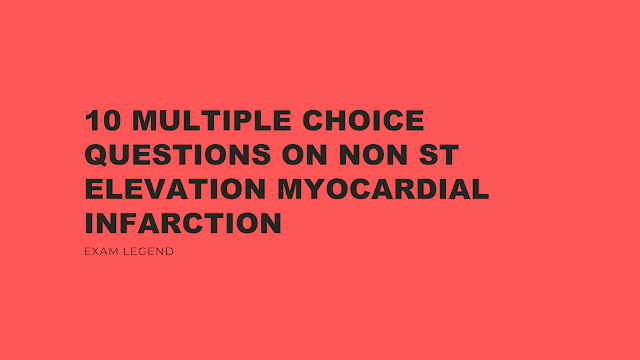Multiple choice questions on non ST elevation myocardial infarction (NSTEMI) and its treatment options:
What is NSTEMI?
a. A heart attack caused by a blood clot in a coronary artery
b. A heart attack caused by a spasm in a coronary artery
c. A heart attack caused by a tear in a coronary artery
d. A heart attack caused by a blockage in a coronary artery
Answer: d. A heart attack caused by a blockage in a coronary artery. NSTEMI is a type of heart attack that occurs when a blockage in a coronary artery partially reduces blood flow to the heart. This can lead to damage to the heart muscle and may cause symptoms such as chest pain, shortness of breath, and nausea.
What are some risk factors for NSTEMI?
a. High blood pressure
b. High cholesterol
c. Smoking
d. All of the above
Answer: d. All of the above. Some common risk factors for NSTEMI include high blood pressure, high cholesterol, and smoking. Other risk factors may include obesity, diabetes, and a family history of heart disease. It's important to manage these risk factors to help reduce your risk of NSTEMI.
What are some common symptoms of NSTEMI?
a. Chest pain or discomfort
b. Shortness of breath
c. Nausea or vomiting
d. All of the above
Answer: d. All of the above. NSTEMI can cause a range of symptoms, including chest pain or discomfort, shortness of breath, and nausea or vomiting. Other symptoms may include fatigue, sweating, and a feeling of impending doom. If you experience any of these symptoms, it's important to seek medical attention as soon as possible.
How is NSTEMI typically diagnosed?
a. With a physical examination and medical history
b. With an electrocardiogram (ECG)
c. With a blood test to measure cardiac enzymes
d. All of the above
Answer: d. All of the above. NSTEMI is typically diagnosed with a combination of a physical examination and medical history, an electrocardiogram (ECG), and a blood test to measure cardiac enzymes. These tests can help your healthcare provider determine the extent of the damage to your heart and the best course of treatment.
How is NSTEMI typically treated?
a. With medications to dissolve the blockage in the coronary artery
b. With a procedure to open the blocked artery
c. With lifestyle changes and medications to manage risk factors
d. All of the above
Answer: d. All of the above. Treatment for NSTEMI may include medications to dissolve the blockage in the coronary artery, a procedure to open the blocked artery, and lifestyle changes and medications to manage risk factors. The specific treatment plan will depend on the severity of the blockage and the overall health of the patient.
What is the primary goal of treatment for NSTEMI?
a. To relieve symptoms
b. To restore blood flow to the heart
c. To prevent future heart attacks
d. All of the above
Answer: d. All of the above. The primary goals of treatment for NSTEMI are to relieve symptoms, restore blood flow to the heart, and prevent future heart attacks. This may involve a combination of medications, procedures, and lifestyle changes.
Scenario-based multiple choice questions related to non-ST elevation myocardial infarction (NSTEMI):
1) A 62-year-old male presents to the emergency department with chest pain that has been ongoing for the past 2 hours. He reports a history of hypertension and high cholesterol. An electrocardiogram (ECG) shows ST-segment depression in leads V1-V4. Troponin levels are elevated. What is the most likely diagnosis?
A. NSTEMI
B. STEMI
D. Stable angina
2) A 45-year-old female presents to the emergency department with chest pain that started 1 hour ago. She reports a history of smoking and obesity. An ECG shows no significant changes, but troponin levels are elevated. What is the most likely diagnosis?
A. NSTEMI
B. STEMI
C. Unstable angina
D. Stable angina
3) A 55-year-old male presents to the emergency department with chest pain that has been ongoing for the past 6 hours. He reports a history of diabetes and prior heart attack. An ECG shows ST-segment depression in leads V1-V3. Troponin levels are elevated. What is the most likely diagnosis?
A. NSTEMI
B. STEMI
C. Unstable angina
D. Stable angina
4) A 75-year-old female presents to the emergency department with shortness of breath and chest discomfort that started 2 hours ago. She reports a history of atrial fibrillation and recent heart bypass surgery. An ECG shows no significant changes, but troponin levels are elevated. What is the most likely diagnosis?
A. NSTEMI
B. STEMI
C. Unstable angina
D. Stable angina
5) A 50-year-old male presents to the emergency department with chest pain that started 30 minutes ago. He reports a history of anxiety and panic attacks. An ECG shows no significant changes, and troponin levels are normal. What is the most likely diagnosis?
A. NSTEMI
B. STEMI
C. Unstable angina
D. Stable angina
Answers:
Here are the answers to the scenario-based multiple choice questions related to non-ST elevation myocardial infarction (NSTEMI):
1) A. NSTEMI
2) A. NSTEMI
3) A. NSTEMI
4) A. NSTEMI
5) D. Stable angina

Comments
Post a Comment